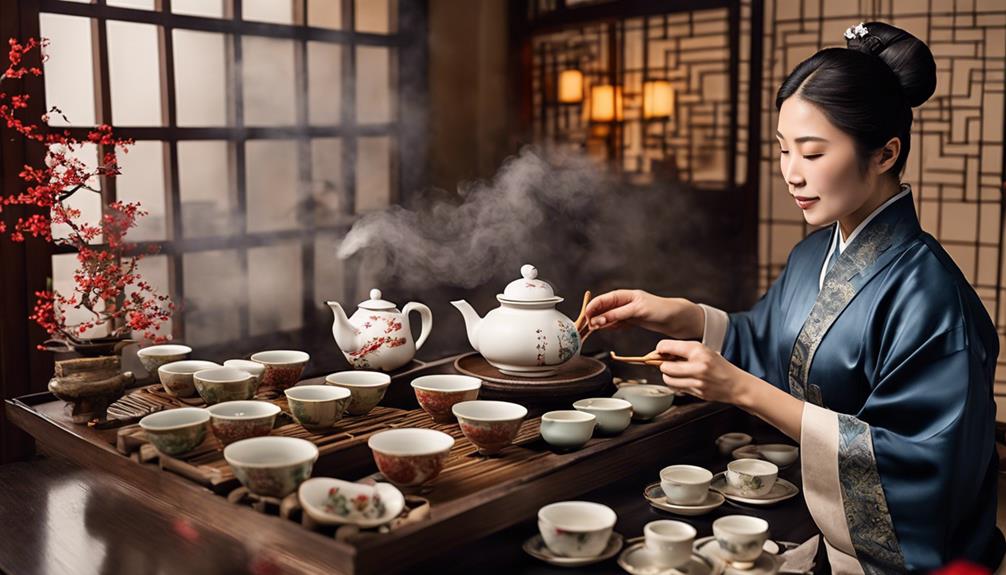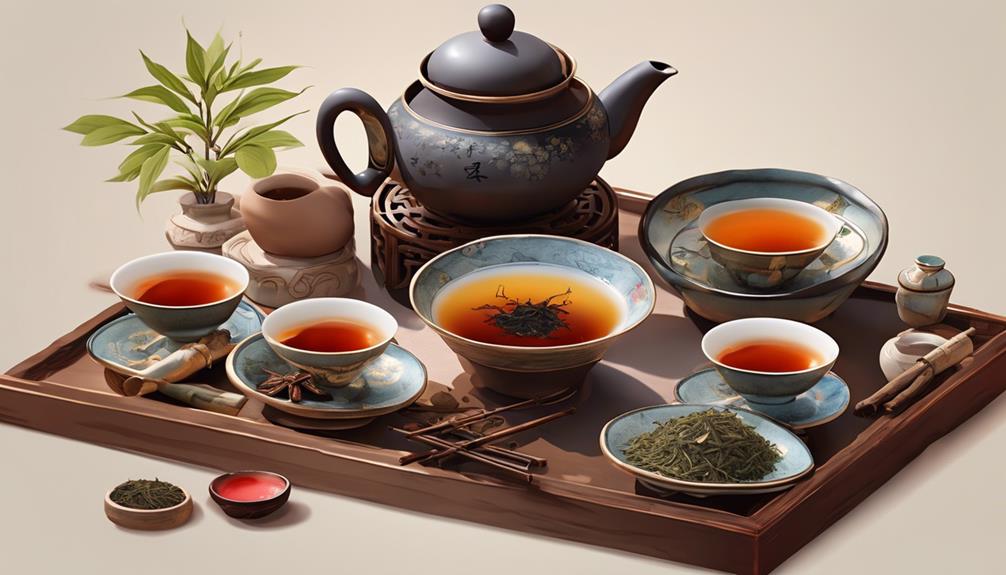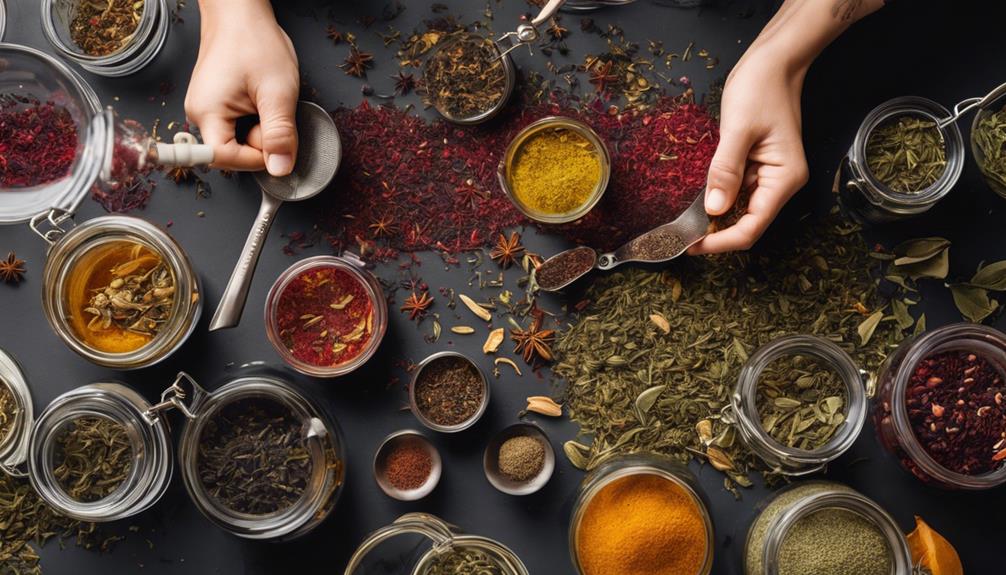When dining at a Chinese restaurant, don't miss the chance to savor the rich cultural flavors of Chinese tea. The intricate aroma and taste of Chinese tea add an authentic touch to your meal, enhancing your overall dining experience. By delving into the origins, varieties, and brewing techniques of Chinese tea, you'll gain a deeper understanding and appreciation for this ancient tradition. Embrace the tradition of pairing tea with Chinese cuisine to elevate your dish's flavors. Discover the world of Chinese tea beyond the restaurant by unraveling its history, health benefits, and modern trends.
Key Takeaways
- Chinese restaurants typically serve varieties like green, oolong, or jasmine tea.
- Tea enhances the dining experience and aids digestion.
- Tea is often complimentary in Chinese restaurants.
- Tea is deeply ingrained in Chinese culinary culture.
- Pairing tea with dishes elevates flavors and authenticity.
The History of Chinese Tea

Discover the intriguing journey of Chinese tea, tracing back centuries to its roots in ancient China. Tea holds a deep cultural significance in Chinese history, where it wasn't just a beverage but a symbol of respect, tradition, and harmony.
The tea trade played a crucial role in connecting China with the rest of the world, influencing global commerce and diplomatic relations.
Since ancient times, Chinese tea has been a highly sought-after commodity, leading to the establishment of the famous Tea Horse Road, a trade route connecting Southwest China to Tibet. This route facilitated the exchange of tea for horses, further enhancing the cultural significance of tea in China and beyond.
Through the tea trade, Chinese tea spread across different regions, introducing diverse brewing methods, flavors, and customs.
Today, Chinese tea continues to be a fundamental aspect of Chinese culture, celebrated for its health benefits, rituals, and social gatherings. The rich history of Chinese tea reflects a profound connection between tradition, trade, and cultural identity.
Tea Culture in China
Tea culture in China thrives as a vibrant tapestry woven with traditions, rituals, and social interactions that have endured for centuries. Tea ceremonies and traditional practices play a significant role in Chinese society, symbolizing respect, hospitality, and harmony. These ceremonies vary across regions, reflecting the diverse tea culture present throughout China.
In different areas of China, you'll find unique customs and rituals associated with tea preparation and consumption. For example, in the southern regions like Fujian and Guangdong, oolong and jasmine teas are popular, often served during elaborate ceremonies that emphasize the art of tea brewing.
On the other hand, in the western provinces such as Sichuan and Yunnan, you may encounter the traditional practice of tea tasting where the focus is on appreciating the flavors and aromas of the tea.
Exploring the regional differences in tea culture enables you to uncover the rich history and customs that have shaped China's longstanding relationship with this beloved beverage.
Health Benefits of Chinese Tea

In addition, many studies have highlighted the various health benefits associated with regularly consuming Chinese tea. Chinese tea is rich in antioxidants, which can help in weight loss by boosting metabolism and aiding in fat burning. Moreover, the digestive benefits of Chinese tea are well-documented, as it can help soothe stomach issues and improve overall digestion. Additionally, many people find that sipping on a warm cup of Chinese tea can provide stress relief and relaxation after a long day.
To further illustrate the health benefits of Chinese tea, consider the following table:
| Health Benefit | Description |
|---|---|
| Tea antioxidants | Help in weight loss by boosting metabolism and aiding in fat burning |
| Weight loss | Can assist in shedding extra pounds through its metabolism-boosting properties |
| Digestive benefits | Soothes stomach issues and aids in improving overall digestion |
| Stress relief | Provides relaxation and helps in reducing stress levels |
Popular Chinese Tea Varieties
Among the diverse selection of teas originating from China, you can explore a range of popular varieties that offer unique flavors and aromas. Some of the most well-known Chinese teas include green tea, black tea, oolong tea, white tea, and Pu-erh tea. Each type has its own distinct characteristics and brewing methods.
Green tea, such as Longjing or Dragon Well, is famous for its fresh and grassy taste, while black tea like Keemun boasts a bold and malty flavor profile. Oolong tea, like Tie Guan Yin, falls between green and black tea with a partially oxidized taste. White tea, such as Bai Hao Yin Zhen or Silver Needle, offers a delicate and subtle flavor. Pu-erh tea, known for its earthy tones, can be aged to enhance its taste.
These popular Chinese tea varieties aren't only enjoyed for their flavors but also for their health benefits. Chinese tea ceremonies often highlight the importance of mindfulness and relaxation while savoring the tea, contributing to overall well-being.
Brewing Techniques and Tips

To brew Chinese teas effectively, it's essential to pay attention to water temperature and steeping times. Proper tea brewing involves precise temperature control. Different types of Chinese teas require specific temperatures for best flavor extraction. For example, green teas generally brew best at lower temperatures around 175-185°F, while black teas benefit from hotter water around 200-212°F. Oolong teas fall in between, usually brewed at 185-205°F. Maintaining the correct temperature is vital to avoid bitterness or a lack of flavor in your tea.
Tea steeping, or infusion time, is equally important. The duration that tea leaves are left in hot water determines the strength and taste of the brew. Typically, delicate teas like white or green teas require shorter steeping times, usually 1-3 minutes, to prevent bitterness. Black teas can be steeped for 3-5 minutes, while oolong teas may need 4-7 minutes. Adjusting infusion time according to your taste preferences ensures a perfect cup of Chinese tea every time.
Pairing Tea With Chinese Cuisine
For a truly authentic dining experience, consider how different Chinese teas can complement the flavors of your favorite dishes. Tea pairings with Chinese cuisine are deeply rooted in traditional customs, enhancing the overall dining experience.
When enjoying delicate seafood dishes like steamed fish or shrimp dumplings, a light and floral green tea such as Jasmine tea can elevate the flavors without overpowering the dish. The subtle notes of jasmine in the tea create a harmonious balance with the seafood's natural sweetness.
If you're indulging in rich and savory dishes like Peking duck or braised pork belly, a robust Oolong tea like Tie Guan Yin is an excellent choice. The tea's roasted aroma and complex flavors cut through the richness of the meat, cleansing your palate with each sip.
For spicy Sichuan dishes or flavorful dim sum, a classic Pu-erh tea can provide a smooth and earthy contrast, balancing the heat and intensity of the flavors. Experimenting with different tea pairings can add a layer of authenticity and tradition to your Chinese dining experience.
Tea Ceremonies and Etiquette

Explore the traditional Chinese tea ceremonies and etiquette to enhance your appreciation of this ancient beverage. In Chinese culture, tea holds deep symbolism and is often associated with harmony, respect, and tranquility. Tea ceremonies aren't just about drinking tea; they're intricate rituals that embody cultural values and traditions.
Tea serving in China follows specific customs that date back centuries. When serving tea, the host pours the tea for the guests as a sign of respect. The way the teapot is held, the cups are presented, and the gestures used all play a part in the ceremony. The act of serving tea is a form of art that requires grace and precision.
Understanding the symbolism and rituals behind Chinese tea ceremonies can add a layer of depth to your tea-drinking experience. Whether you're hosting a tea gathering or participating as a guest, paying attention to the customs and etiquette involved can help you fully appreciate the beauty and significance of this cultural practice.
Sourcing Authentic Chinese Tea
Discovering authentic Chinese tea involves exploring various regions known for their unique tea cultivation methods and rich tea-making traditions. When it comes to tea sourcing, authenticity is key. China, the birthplace of tea, boasts a diverse range of tea origins and varieties. From the floral notes of Jasmine Green Tea to the earthy flavors of Pu-erh, each type of Chinese tea offers a distinctive taste profile that reflects its specific region of origin.
For those seeking authenticity, delving into the origins of Chinese tea can be a fascinating journey. Green tea hailing from the lush mountains of Zhejiang, or Oolong tea cultivated in the rocky cliffs of Fujian, each region contributes its own expertise to the art of tea-making. By understanding these origins and varieties, tea enthusiasts can truly appreciate the nuances of authentic Chinese tea.
Next, we'll explore how you can create your own unique blends at home with the DIY Tea Blending at Home subtopic.
DIY Tea Blending at Home

Explore the art of tea blending at home to create your own unique and personalized tea combinations. Experiment with herbal infusions and creative flavors to craft teas that suit your taste preferences perfectly. When tea blending, consider the aroma profiles of different teas to create harmonious blends that tantalize your senses.
To start your DIY tea blending journey, gather a variety of loose leaf teas such as green tea, black tea, and oolong tea. Additionally, collect a selection of herbs, spices, and dried fruits to add depth and complexity to your blends. Try combining floral notes with citrusy flavors or earthy undertones with a hint of sweetness to create a well-balanced cup of tea.
Pay attention to the brewing times and temperatures of each ingredient to make sure that the flavors meld together seamlessly. Keep a journal to record your recipes and adjustments, allowing you to refine your blends over time.
With practice and creativity, you can master the art of tea blending and enjoy a customized tea experience in the comfort of your home.
Modern Trends in Chinese Tea
To stay up to date with the latest developments in the world of tea, let's take a look at the modern trends shaping the Chinese tea industry. In recent years, Chinese tea producers have been embracing tea innovations and sustainability practices to meet the demands of conscious consumers. Sustainability is a key focus, with many tea farms adopting eco-friendly methods such as organic farming and reducing carbon footprints.
Tea rituals and mindfulness are also gaining popularity among tea enthusiasts. Instead of rushing through a cup of tea, people are taking the time to appreciate the flavors, aromas, and overall experience. The practice of mindfulness while drinking tea allows individuals to be fully present in the moment, savoring each sip and finding relaxation in the process.
Conclusion
So next time you visit a Chinese restaurant, don't forget to enjoy a cup of traditional Chinese tea.
Not only is it a delicious and invigorating beverage, but it also carries a rich history and cultural significance.
With its numerous health benefits and wide variety of flavors, Chinese tea is sure to enhance your dining experience.
Cheers to the wonderful world of Chinese tea!




